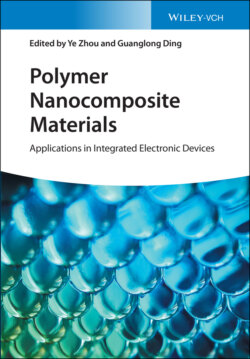Читать книгу Polymer Nanocomposite Materials - Группа авторов - Страница 45
2.5 Conclusion
ОглавлениеDue to its inherent properties of lightweight, low cost, easy fabrication, and controllable resistance, CPCs have been the research hotspot in the past decades. The incorporation of different conductive nanofillers like CNTs, graphene, silver nanoparticles, and silver nanowires greatly enhances the electrical property of CPCs. However, fabricating high performance CPCs still remains a great challenge, because conductive fillers, especially nano-sized conductive particles, are easy to aggregate in the polymer due to their high-aspect ratio, resulting in uneven distribution of fillers.
Nanofiller aggregations would affect or even worsen the performance of CPC. Thus, even dispersion of conductive nanofillers in the polymer matrix is a vital issue. Here, surface modification of nanofillers and special processing technique are raised: (i) the physical blending, (ii) in situ polymerization, (iii) chemical modification of conductive filler, and (iv) introduced surfactant. All of the aforementioned methods can improve the dispersion of conductive particles in polymer, but there are still many disadvantages. Method (i) the polymer may be partially degraded under high shear strength. In addition, when the external force stops, the conductive particles will reunite. In method (ii), the solvent should be carefully chosen, that is, the selected solvent can not only dissolve the polymer monomer and its initiator, but also disperse the conductive filler well. In method (iii), the chemical modification of conductive particles is complicated and the yield is low. The introduction of surfactants in method (iv) may have adverse effects on the mechanical and other properties of polymer materials. Therefore, improving the dispersion of conductive particles in polymer is still a key problem in CPC preparation.
In addition to dispersion, the concentration of conductive filler in polymer matrix is also an important factor affecting the preparation and performance of CPC. Although some methods have been used to decrease the percolation value, there are many limitations for each structure design of the CPCs. For instance, pressure and temperature should be delicately controlled for construction of the segregated structure. Furthermore, CPCs with a segregated structure usually exhibit inferior mechanical properties. Coating conductive nanofillers on the surface of polymer nanofibers or the skeleton of the polymer foams could avoid filler aggregation and increase the electrical conductivity, but how to achieve the good interfacial interaction between nanofillers and polymer scaffold and ensure the surface stability and durability is still challenging.
The flexibility, light weight, and controllable network structure endow the CPCs with potential applications in sensing including strain sensors, piezoresistive sensors, gas sensors, and temperature sensors. With the development of artificial intelligence (e.g. electronic skin and human–machine interface), skin adhesive and mechanically flexible CPCs with multi-functionality will become a new hotspot.
